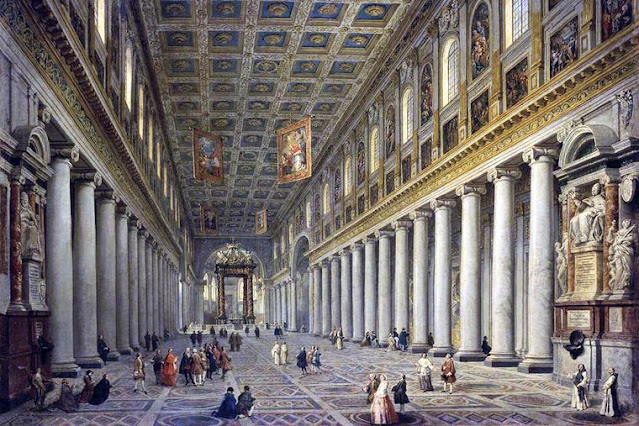On the Feast of Our Lady of the Snows, the Basilica under this title in Rome.
Our Lady of the Snows
Rev. Matthew R. Mauriello
The most important church in the city of Rome dedicated to Our Lady is the Basilica of Saint Mary Major, erected around the year 352, during the reign of Pope Liberius. ( 352-366 ) According to legend, a member of an aristocratic family, John and his wife were childless and prayed that the Blessed Mother might designate an heir to bequeath their wealth. They were favored with a dream in which Our Lady appeared to them on the night of August 4-5. She requested that they build a church in her honor on the Esquiline hill and the sign to accompany this dream is that the exact location would be marked out in snow.
During that hot summer evening, a miraculous snowfall traced the form of the basilica on the hill. Our Lady also appeared to Pope Liberius in a dream that same night so that he too could arrive at the location to see the miraculous snowfall. Many people gathered to see the unusual event of snow glistening in the August sun. Upon awakening, John and his wife rushed to the site and Pope Liberius arrived in solemn procession.
Realizing that the snow marked the exact location of the church, the people staked off the area before the snow melted. The basilica was completed within two years and consecrated by Pope Liberius, that is why it is sometimes referred to as the Basilica Liberiana, after the Pope who consecrated it.
When the Council of Ephesus defined Mary as Theotokos, the God-bearer, in 432 A.D., Pope Sixtus III ( 432-440 ) rebuilt and embellished the basilica. From the seventh century onward, it was referred to as St. Mary the Great or Major. The Basilica has also been called Our Lady of the Snows in commemoration of the miraculous snowfall. The imposing facade was built by Pope Eugene III ( 1145-1153 )
Among its great treasures is a painting of the Madonna and Child known as the Salus Populi Romani , the Protectress of the People of Rome, which is attributed to St. Luke. This image had been brought back from the Holy Land by St. Helena, the mother of the Emperor Constantine, who also located the True Cross and other Relics of the Passion in Jerusalem. The venerable picture hung in the private chapel of Pope Liberius and he ordered that it be brought to the Basilica for public veneration by the faithful.
Throughout the centuries there has been a special devotion to this famous picture of Our Lady. During the pontificate of Pope St. Gregory the Great ( 590-604 ) a plague attacked the people of Rome and the Pope carried the image in procession to pray to their Protectress for an end to the plague. In 1837, Pope Gregory XVI ( 1830-1846 ) also carried the image in procession throughout Rome to ask Our Lady for an end to an epidemic of cholera. When it soon ended , the Pontiff solemnly placed crowns of gold and gems on the heads of Mary and the child Jesus on the miraculous image.
Pope Paul V ( 1605 - 1621 ) arranged that a magnificent Chapel be built for the veneration of the image. On January 27, 1613, it was removed from the high altar and placed in the new chapel. The manger from the stable of Bethlehem is venerated under the high altar of the basilica.
The liturgical feast of the Dedication of the Basilica of St. Mary Major is celebrated each year on the fifth of August. On that day, a beautiful custom is kept each year to commemorate the miraculous snowfall. At the conclusion of the Solemn Mass a shower of white rose petals falls from the dome of the Chapel of Our Lady.










.jpeg)

Comments